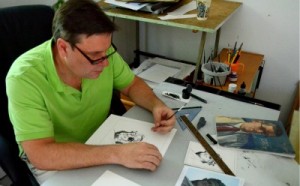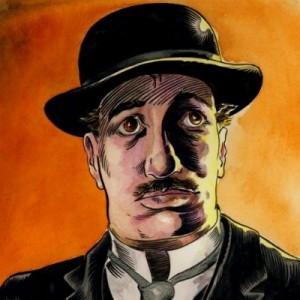As we walk from our meeting place at the Starbucks in the Fairmount section of Philadelphia to Rob Berry’s studio, just a few blocks away, Berry asks the question I’d been both anticipating and dreading: “Have you read ‘Ulysses?’” At which point, I came clean and admitted I hadn’t.
(Although, in my clearly woeful preparation for the interview, I had read the Sparks Notes.)
My ignorance of Irish poet and novelist James Joyce in general and his 1922 masterwork, in particular, apparently didn’t put Berry off. He seemed happy that I hadn’t tried to bluff my way through. He’s asked others the same question, and they’ve, well, lied. Berry himself admits he attempted to read the labyrinthine 265,000-word novel five times before he could make it all the way through.
Still, the fifth time was the charm. Berry got it—and he was hooked.
But perhaps even Berry could not have predicted where his Joycean passion someday might lead. Berry—with graphic and web designer Josh Levitas, Joyce scholar Mike Barsanti and several other equally talented colleagues—is in the early stages of publishing a Web- and iPad-based comic adaptation of “Ulysses.” Two chapters, complete with hypertext-linked reader’s guide, have been published on the Web site “Ulysses ‘Seen’.”
If you’re looking for a way to get a handle on this classic of modernist literature, with its allusions to Homer’s “Odyssey,” its rich symbolism and subtle nuances, “Ulysses ‘Seen’” might be just your ticket.
The project was hatched in June 2004, appropriately enough, in an Irish bar—The Bards at 20th and Walnut—during the Bloomsday Centennial. Bloomsday is the worldwide celebration of Ulysses, held every June 16, which takes its name from Leopold Bloom, who serves as Joyce’s Everyman. All of the events of “Ulysses” occur on that single day in Dublin.
“I was at a Bloomsday reading with a friend of mine who was a cartoonist,” Berry recalls, and talk turned to how “Ulysses” might be portrayed in film. “We were talking about how difficult it is to translate Joyce into other mediums. I was the one to say comics were ideally suited. Joyce uses the weight of visual symbols and he also uses a plasticity of time that you can’t put on film. What you are able to do with comics is to set a rhythm to it (the story) that’s visual, that allows people to know where they are.”
Some who listened to that argument weren’t so sure, and one of his fellow bar patrons bet Berry it couldn’t be done. “I wound up story-boarding 20 pages of ‘Ulysses’,” he says. “I won.”
The idea languished for a few years. in August 2007, at Berry’s wife’s urging, he submitted a snippet from Ulysses to the Philadelphia City Paper for its Comics Issue.
For help in scanning and translating his hand-inked cartoon into a Web-friendly graphic format, he turned to Replica, a high-end print and design shop, which is where Levitas worked. “That’s how I met Josh,” Berry says. “It turned out he actually lives on my block.”
From there, an idea that started out as a barroom bet began to take on a lot more substance. As he continued his wanderings among the “Joyce heads,” Berry met (at a Bloomsday festival) Mike Barsanti, a senior program specialist at the Pew Center for Arts & Heritage and former associate director of the Rosenbach Museum & Library in Philadelphia. He pitched the idea to Barsanti. Barsanti’s reaction was, perhaps, predictable. “At first, he thought it was the craziest idea he’d ever heard,” says Berry, “And Joyce scholars know ‘crazy’.” But the more they talked—over beers, and maybe the brews paradoxically helped lift the fog—the more intrigued Barsanti became, and in time he was on board.
Another partner, copyright attorney Chad Rutkowski—the one who bet that a comic version of Ulysses couldn’t be done—joined the project in 2008 following an encounter at The Bards. Rutkowski became the counsel and business manager for a new company called Throwaway Horse LLC. (Throwaway was the 20-to-1 winner of the Gold Cup race featured in “Ulysses.”)
In time, another passionate Joyce enthusiast joined the project: Janine Utell, former facilitator of the Ulysses Reading Group and Bloomsday coordinator at the Rosenbach, who teaches 20th century British literature at Widener University.
Like a lot of start-up companies, this one is mostly virtual. (Company meetings, Berry says, take place at the Black Sheep near Rittenhouse Square.) If Throwaway Horse can be said to have an “office,” it’s the Callowhill Street studio Berry shared with Levitas.
To reach it, you climb two flights of well-worn gray steps bounded by mustard-colored walls. The studio is a bright, cozy and somewhat cluttered cube, with scuffed white walls and, along one side, exposed brick. At the far end of the studio sits two desks, positioned so they face each other—one of them, covered by illustrations in progress, belonging to Berry; the other, dominated by a large flat-screen monitor, hard drives, a tangle of cables and a pen-and-touch tablet, where Levitas helps translate Berry’s work into an electronic format.
The wall closest to the door is dominated by a cluster of paintings featuring Captain America re-imagined in a wide assortment of characters—black, white, bearded, bespectacled, double-chinned, and one with dark purple lipstick. An equal opportunity Captain America. The theme continues on the wall up above Berry’s left shoulder, where a plastic Captain America costume mask hangs. And here and there, black-and-white comic panels on large sheets of sketchpad paper are tacked into the wallboard.
On the bookshelves, reference works like “Atlas of Human Anatomy for the Artist” and “The Book of a Hundred Hands” share space with ”The Complete Tales of Winnie the Pooh” and the Winston Graham crime novel “Marnie.”
Berry’s musical tastes are eclectic, too. The iPod is set on shuffle, and all the tunes reflect the artist’s diverse interests. It wouldn’t be unusual, Berry laughs, to hear Bach’s “Goldberg Variations” followed by Iggy Pop.
Before moving to Philadelphia in 2000, Berry had an enjoyed a successful career as an artist in Detroit, his easel paintings appearing in many galleries and shows. He says his paintings always followed a narrative style, in effect, telling a story. When he moved to Philadelphia, he says, “I didn’t want to do easel painting any more. The stories were becoming more important to me than the paintings themselves. I started to move away from paint to watercolor and ink drawing. It’s a faster medium to work in and better for print.”
For a time, he considered working in the world of mainstream superhero comics—not surprising, perhaps, for an artist who counts among his earliest creative influences the great comic artists Hal Foster (Prince Valiant), Burne Hogarth (Tarzan) and the immortal Jack Kirby (Captain America, Fantastic Four, X-Men and probably dozens of other comic creations).
Ultimately, though, the idea of creating longer-form stories was more appealing.
And then, in 2007, Steve Jobs and Apple introduced the iPhone. Berry knew things would never be the same, and he began to see creative possibilities on the Web, and—with the dawning of the iPhone—beyond. That’s when Berry’s thoughts about creating a comic version of “Ulysses,” which he had put on a back burner, popped back into his head again. “It all came back when I started to think about the digital page,” he says. “At that point I barely knew how to type. I knew that if I was going to reinvent, I was going to have to reinvent everything.
“I started to look at what had been done with CD-ROMs and hypertext. Hypertext (the presentation of intertwining text, graphics and other info on the Web) was a really exciting approach. With hypertext, you can go behind the page and go right to the reader’s guide. You can join a discussion from there.”
In 2009, Berry and his colleagues launched “Ulysses ‘Seen’” with the publication of the first chapter, “Telemachus.” In 2010, Apple introduced the iPad. In the same year—after a brief media-fueled dust-up resulting in changes to Apple’s prohibition against depictions of nudity and lots more attention to the project—”Ulysses ‘Seen’” became one of the first creative applications for the iPad. “We were geared to the idea that the iPad would come out,” Berry says, “and we would be ready.”
Interestingly, although “Ulysses ‘Seen’” appears in an electronic format, Berry creates the world of “Ulysses” by hand, his panels later scanned by Levitas. “I still use a brush. I still use water colors. It works for me.”
Overall, the process of creating “Ulysses ‘Seen’” is hugely time-consuming. Drawing on the 1922 version of “Ulysses,” which is in the public domain, the team plots out scenes and chapters, with multiple layers of review and re-review. It’s a comic, yes, but there’s an almost academic level of integrity to what the Throwaway Horse team is trying to do.
So, yes, it takes a long time, but the results are stunning. Berry’s renderings of characters like the unhappy Stephen Dedalus, for example, are almost three-dimensional and meticulously detailed. Dedalus fairly pops off the page, in all his unwashed misery, living out the nightmare from which he is trying to awake.
In at least one way, “Ulysses ‘Seen’” is following in the footsteps of the original, which was serialized. The electronic comic version, though, has a much longer timeline. “We’re expecting to be able to do two chapters a year,” he says.
Judging by the critical acclaim with which the first two chapters have been received, it’s well worth the wait.
You can share the Throwaway team’s enthusiasm for Ulysses this week as the Rosenbach hosts the annual all-day outdoor reading of “Ulysses” at its Delancey Place location on Thursday, June 16, from 12 noon to 7 p.m. Berry and Levitas are scheduled to read from 12:55 to 1.
Berry and company are also promoting “Gibraltar: An Adaptation After James Joyce’s Ulysses,” at Plays & Players, 1714 Delancey Place. Showtimes are:
- Wed, June 15 at 7pm ($15)
- Thursday, June 16 at 11am and 3pm ($15)
- Saturday, June 18 at 5pm ($25)


